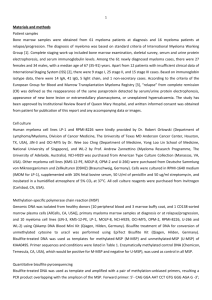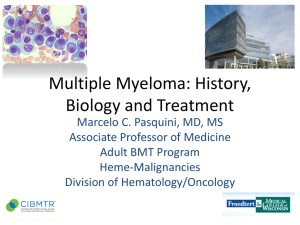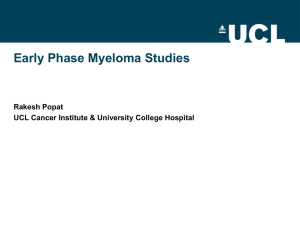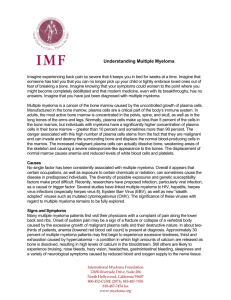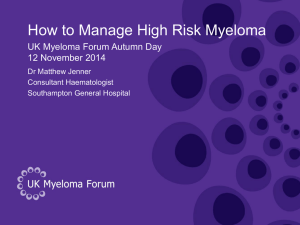Multiple myeloma
advertisement
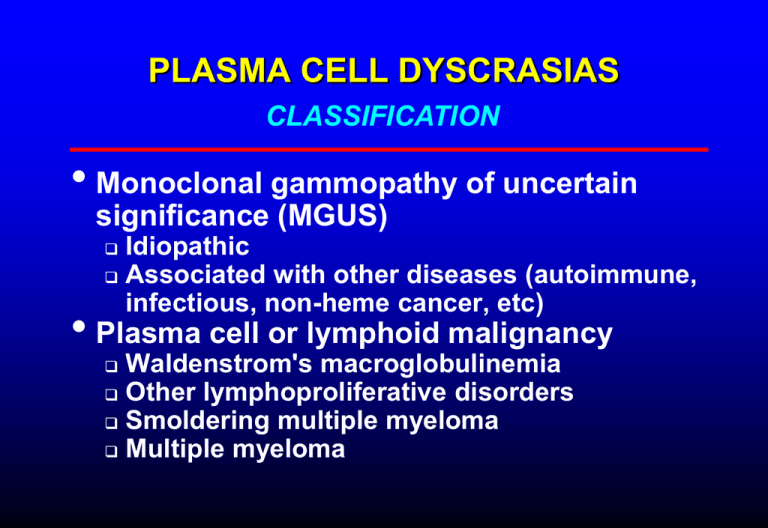
PLASMA CELL DYSCRASIAS CLASSIFICATION • Monoclonal gammopathy of uncertain significance (MGUS) Idiopathic Associated with other diseases (autoimmune, infectious, non-heme cancer, etc) • Plasma cell or lymphoid malignancy Waldenstrom's macroglobulinemia Other lymphoproliferative disorders Smoldering multiple myeloma Multiple myeloma MOLECULAR PATHOGENESIS OF MYELOMA Lancet 2004;363:875 MULTIPLE MYELOMA Definition • • • Increased numbers of abnormal or immature plasma cells in the bone marrow, or localized plasmacytoma Monoclonal protein in blood or urine Some patients are nonsecretors Lytic bone lesions Not all patients have lytic bone disease MULTIPLE MYELOMA EPIDEMIOLOGY • Incidence in US approx 3 cases/100,000/yr • 98% of cases > 40 yrs old • Risk factors: genetic radiation exposure ? chemical exposure MULTIPLE MYELOMA Serum and urine protein electrophoresis Monoclonal IgG Serum Urine Free light chain Multiple myeloma (IgG kappa) IgG 2080 Anemia, leukopenia Lytic bone lesions 10% marrow plasma cells Multiple myeloma (IgA) IgA 1010 (nl 70-140) IgG 165 (nl 695-2190) IgM 14 (nl 60-265) Anemia, thrombocytopenia 16% marrow plasma cells MGUS Ifix: monoclonal IgG kappa No proteinuria IgA 234 (50-540) IgG 1840 (600-1600) IgM 85 (40-250) Normal CBC Waldenstrom macroglobulinemia with hyperviscosity syndrome Anemia, fatigue, retinopathy, bleeding disorder IgA 125 (70-440) IgG 724 (695-2190) IgM 5130 (60-265) Serum viscosity 3.6 Marrow: <5% plasmacytoid B-lymphocytes Waldenstrom macroglobulinemia Mild fatigue IgM 8460, serum viscosity 2.7 Hgb 12, WBC 3700, platelets 143,000 Marrow: 50% plasmacytoid B-lymphocytes Kappa light chain myeloma with cardiac amyloidosis Serum (hypogammaglobulinemia) Urine (kappa light chain) Always check the urine! MULTIPLE MYELOMA – BONE MARROW ASPIRATE MYELOMA CYTOGENETICS t(4;14) del (13) Lancet 2004;363:875 MULTIPLE MYELOMA DIAGNOSIS • Monoclonal paraprotein Intact immunoglobulin in serum (SPEP) Light chains in serum or urine (IEP) • Marrow plasmacytosis (> 20% - may be patchy) • Lytic bone lesions • Plasmacytoma MULTIPLE MYELOMA CLINICAL MANIFESTATIONS • Anemia progressing to pancytopenia • Bone pain/destruction • Hypercalcemia • Humoral immune defect • Local effects of plasmacytomas • Systemic effects of paraprotein MONOCLONAL GAMMOPATHY COMPLICATIONS • Hyperviscosity (IgM >> IgA > IgG) • Renal dysfunction (light chains) Glomerular Tubular Neuropathy Other organ damage (rare) Cryoglobulinemia (types I and II) Amyloidosis • • • • MULTIPLE MYELOMA Cast nephropathy CRYOGLOBULINEMIA IN IgM GAMMOPATHY Brit J Haematol 2004; 124:565 MULTIPLE MYELOMA Demographics Mayo Clin Proc 2003;78:21 MULTIPLE MYELOMA Presenting features (1027 pts) Mayo Clin Proc 2003;78:21 Bone pain 58% Fatigue 32% Weight loss 24% Paresthesias 5% Fever 0.7% ECOG PS >2 10% MULTIPLE MYELOMA Preexisting conditions and risk factors Mayo Clin Proc 2003;78:21 Cancer in 1st degree relative 42% Myeloma in 1st degree relative 2% Hx of plasma cell proliferative disorder 34% MULTIPLE MYELOMA Pre-existing plasma cell disorders Mayo Clin Proc 2003;78:21 MULTIPLE MYELOMA Physical findings Mayo Clin Proc 2003;78:21 Palpable liver 4% Palpable spleen 1% Lymphadenopathy 1% MULTIPLE MYELOMA Hematologic findings at presentation Mayo Clin Proc 2003;78:21 Hgb < 12 73% Hgb < 8 7% ESR > 20 84% ESR > 100 33% WBC < 4000 20% WBC < 2000 1% Plts < 100K 5% Plts > 500K 2% MULTIPLE MYELOMA Laboratory findings Mayo Clin Proc 2003;78:21 MULTIPLE MYELOMA Serum and urine proteins Mayo Clin Proc 2003;78:21 Monoclonal band on SPEP in 82% 3% non-secretory at presentation MULTIPLE MYELOMA Types of monoclonal proteins Mayo Clin Proc 2003;78:21 MULTIPLE MYELOMA Radiographic findings at presentation Mayo Clin Proc 2003;78:21 MULTIPLE MYELOMA Survival Mayo Clin Proc 2003;78:21 MULTIPLE MYELOMA Prognostic factors Mayo Clin Proc 2003;78:21 * * * * * * Most important factors in multivariate analysis *Adapted from Greipp et al, Blood 2003;102:190a Adverse cytogenetics in myeloma del13 or del13q t(4;14 del17p MULTIPLE MYELOMA INDICATIONS FOR TREATMENT • Symptomatic disease • Bone destruction • Anemia • Organ dysfunction • Hypercalcemia • Increasing paraprotein microglobulin level or ß2- Treatment mnemonic • Calcium increased • Renal dysfunction • Anemia • Bone lesions MULTIPLE MYELOMA TREATMENT • Initial treatment: – Thalidomide or lenalidomide + dexamethasone – Bortezomib + dexamethasone – Bortezomib + lenalidomide + dexamethasone – Melphalan + prednisone + lenalidomide/thalidomide • Autologous SCT prolongs survival • Refractory disease: – High dose cyclophosphamide – Platinum-based regimen • Bisphosphonates as adjunctive Rx • Allogeneic transplant role? Overall and progressionfree survival in multiple myeloma: standard chemotherapy vs highdose chemotherapy with stem cell rescue NEJM 2003;348:1875 Blood 2010;116:679-686 N Engl J Med 1996;334:488-93 Lancet 2004;363:875 How do thalidomide & related drugs work? Science 2014;343:256


